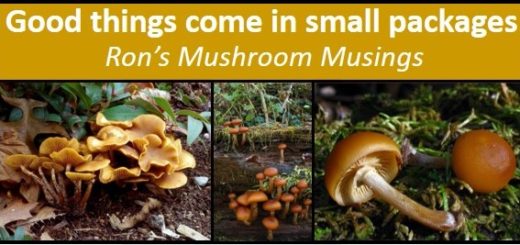A Honey of a Mushroom
Isn’t it interesting how we give nicknames to mushrooms that already have such eloquent Latin or Greek names? We call Russula Xerampeline the Shrimp Russula, Agaricus Augustus the Prince, and Clitopilus prunulus the Spy, the Sweetbread mushroom and also the Miller; must be some mushroom to deserve so many nicknames.

Then there is Armillaria mellea, which we call the Honey mushroom. Now that makes some sense since Melle is Latin for Honey and does kind of reflect the cap color of this particular species. And that would be the end of this story if only it was a real honey of a mushroom and if it was really the Armillaria species we find in Oregon. So, is any of this true? Oh, Hell No! Ever since the creation of the microscope, DNA analysis, and the advent of Mycologists, nothing is simple or straightforward anymore. First off, Armillaria mellea may not even occur in Oregon so no mellea, no Latin Melle, therefore no honey.

Our most common species is believed to be Armillaria ostoyae; however, it has been determined that we have several species in our area. This is best described by an excerpt from Steve Trudell & Joe Ammirati’s book “Mushrooms of the Pacific Northwest”. “At least 4 of the 8 named North American honey mushrooms occur in the PNW – Armillaria nabsnona, A. ostoyae, A. gallica, and A. sinapina – plus the still unnamed North American biological species X and XI. The true A. mellea has not been reported from our region, although it does occur in California.”
So, to make it easy on everyone and since new species of Armillaria are still being unearthed, we call this ever-evolving group the “Armillaria Mellea Complex” to which I will use the abbreviation AMC (not be confused with the defunct American Motors Corporation). Now that we know what we don’t know about the AMC, let’s look at how well they play with others. Most species within this complex are content munching on trees that are dead or in their final death throes.

These saprotrophic species behave much like many of our other decomposers converting the remains of organic matter from one form into another, such as wood solids being returned to the earth from whence they came. On the other hand, some of them are not that benign. You might remember this far side comic, which is quite descriptive of Armillaria ostoyae. It has the ability to act as both a saprotroph and a parasitic fungus. “These are the voyages of the Armillaria ostoyae. Its continuing mission: to explore strange new forests, to seek out and eat new trees, to boldly go where no fungus has gone before.” Unlike other fungi, ostoyae has digestive enzymes capable of penetrating any anti-fungal armor that trees can create.

When looking for new food sources the fungus generates root-like structures called rhizomorphs which spread out in an effort to locate a new tree. Once contact has been made these rhizomorphs begin to envelop the tree and start the digestive process, thereby expanding its perimeter.

The largest occurrence of Armillaria ostoyae is in Oregon in the Malheur National Forest encompassing an astounding 3.5 square miles of area, and growing larger each year. Based on its current size and expansion rate, some have estimated this fungal patch to be over 8,000 years old. It has the distinction of being the largest living organism on our planet. Once considered edible back when we were all younger and blissfully ignorant about all this DNA mumbo jumbo, most have now elected to pass on preparing our favorite honey mushroom Jambalaya recipe or making honey mushroom smoothies. So don’t look for this mushroom to appear at any of your local grocery stores any time soon. As for now, you will only find it in the wilds of Oregon eating a forest somewhere near you.
Since descriptions of each species within the AMC vary and is being constantly updated, it is best to find descriptions of these fungal species online. A link to Armillaria ostoyae has been included below. Live long and prosper and don’t fall asleep leaning against a tree inhabited by the ostoyae species. You could be innocently mistaken for just another food source.
Link to Wikipedia on the Armillaria ostoyae
Photo of Armillaria mellea courtesy of Wikimedia.org
Photo of Armillaria ostoyae courtesy of National Geographic Australia
Photo of rhizomorphs courtesy of Pioneer Valley Mycological Association (PVMA).
Photo of Google Map area overlay courtesy of OPB website article





